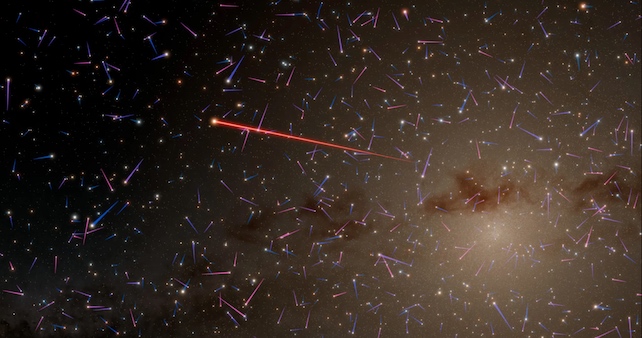A groundbreaking discovery has left scientists astonished—a mysterious star and its possible planetary companion are hurtling through the Milky Way at speeds never seen before. If confirmed, this could be the fastest-moving planetary system ever identified, pushing the limits of what we know about high-velocity celestial bodies.
Deep in the bustling heart of our galaxy, around 24,000 light-years from Earth, a rapidly moving object has caught the attention of astronomers. Initial analysis suggests it could be a hypervelocity star with a planet in tow, defying expectations of how fast planets can travel.
To put this into perspective, most stars in the Milky Way cruise along at hundreds of thousands of miles per hour. Even our Sun drifts through space at around 450,000 mph (200 km/s). However, this newly discovered system is moving at a blistering 1.2 million mph (540 km/s)—more than twice as fast as our Solar System.
NASA scientists working on this study suspect that the object accompanying this fast-moving star might be a super-Neptune—a planet significantly larger than Earth but not quite as massive as a gas giant like Jupiter.
“We think this is a so-called super-Neptune world orbiting a low-mass star at a distance that would lie between the orbits of Venus and Earth if it were in our solar system,” says astronomer Sean Terry from the University of Maryland and NASA’s Goddard Space Flight Center. “If so, it will be the first planet ever found orbiting a hypervelocity star.”
From an Enigmatic Signal to a Decade-Long Mystery
The journey to this discovery began over a decade ago in 2011, when researchers scanning data from the Microlensing Observations in Astrophysics (MOA) project noticed an unusual signal. The data revealed two objects—one 2,300 times more massive than the other—but their exact nature was unclear.
At the time, scientists proposed two possibilities:
- It could be a star with a massive planet, with the star weighing slightly less than our Sun and the planet around 29 times the mass of Earth.
- Alternatively, it might be a rogue super-Jupiter, dragging a much smaller moon along for the ride.
Fast forward to 2025, and new observations from the Keck Observatory in Hawaii and the European Space Agency’s Gaia mission have shed fresh light on the mystery. Using precise measurements of its distance and motion, astronomers now believe they have pinpointed this system’s true nature—likely a planet and star moving at record-breaking speeds.
Is This System Escaping the Milky Way?
One of the biggest questions surrounding this discovery is whether this speeding star is on a trajectory that could carry it beyond the Milky Way’s gravitational grip. Scientists estimate that the escape velocity of the Milky Way is around 550-600 km/s. If this system’s total motion exceeds that threshold, it may eventually leave our galaxy and drift through intergalactic space.
However, even if this is the case, it won’t be a quick exit—it would take millions of years for this system to truly break free from the Milky Way’s influence.
Despite the compelling evidence, one last test remains. Astronomers plan to revisit the system in a year to confirm whether its movement aligns with the predicted trajectory.
Regardless of the outcome, this discovery is forcing astronomers to rethink how planets and stars move through space, challenging long-held assumptions about celestial dynamics.











